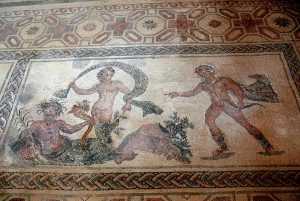Roman Gods and Heroes
34 The Metamorphoses

The Roman poet Ovid published his epic poem, the Metamorphoses, in 8 CE. It is his longest work, composed of 11, 995 lines of poetry over 15 books. It contains more than 250 myths, many of them Greek in origin, and runs from the origin of the universe through the deification of Julius Caesar. It is written in dactylic hexameters, the epic meter that is also used for the Iliad, the Odyssey, the Homeric Hymns, and Virgil’s Aeneid.
The poem is organized around the theme of changing bodies and forms, hence the name Metamorphoses. It is an important source for Greco-Roman myth, since it survives in its entirety and covers so much ground. It shows us how many of the Greek myths changed and were adapted in the Roman context. Likely much of the mythically themed artwork from the Roman Empire is based on the versions of myths in the Metamorphoses.
The Metamorphoses has also had an enormous influence on later European poetry and art. It inspired and influenced many works of European literature, including Dante’s Divine Comedy, Boccaccio’s Decameron, Chaucer’s Canterbury Tales, the plays and poems of Shakespeare, and Milton’s Paradise Lost. Renaissance and Baroque European painters also took inspiration from Ovid’s versions of the Greco-Roman myths.
The entire poem can be read here.
Media Attributions
- Paphos_Haus_des_Dionysos_-_Apollo_und_Daphne_1 © Wolfgang Sauber is licensed under a CC BY-SA (Attribution ShareAlike) license

